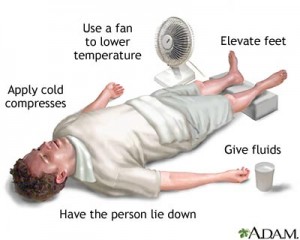Elderly people( people 65 years and older) are more prone to heat stress than younger people for several reasons:
- elderly people do not adjust as well to sudden changes in temperature.
- Elderly are more likely to have a chronic medical condition that changes normal body responses to heat.
- they are more likely to take prescription medicines that impair the body’s ability to regulate its temperature or that inhibit perspiration.
If you have elderly relatives or neighbors, you can help protect themselves from heat-related stress
- visit or call older adults at risk at least twice a day and watch for signs of heat exhaustion or heat stroke.
- encourage them to increase their fluid intake by drinking cool, nonalcoholic beverages regardless of their activity level. WARNING: if their doctor generally limits the amount of fluid they drink or they are on water pills, ask their doctor how much they should drink while the weather is hot.
- take them to air-conditioned locations if they have transportation problems.
There are many ways to avoid overheating that could lead to heat illness or heat stroke. Staying hydrated, avoiding physical activity and keeping in the shade are all ways to stay healthy in the summer, but sometimes that’s not enough. As we age our circulation decreases and it’s harder for our bodies to deal with extreme temperatures.
 It’s important to know the signs of heat exhaustion and heat stroke, as both are even more likely to affect seniors. Seniors do not adjust well to sudden weather changes, and are more likely to have a chronic medical condition that affects how the body deals with heat.
It’s important to know the signs of heat exhaustion and heat stroke, as both are even more likely to affect seniors. Seniors do not adjust well to sudden weather changes, and are more likely to have a chronic medical condition that affects how the body deals with heat.
Heat cramps are a warning sign that heat exhaustion or heat stroke is on its way. Not all heat illness is preceded by heat cramps, but if you do get cramps you should take precaution and cool down immediately. Heat cramps are painful muscle spasms that are more common in the legs, but can occur anywhere (abdomen, back, etc.). Once you have cooled down, gently massage and stretch the affected muscles to relieve cramping.
Heat illness can go far beyond cramping. Before reaching heat stroke there are signs of heat exhaustion. Ignoring heat cramps leads to heat exhaustion, which leads to heat stroke. Signs of heat exhaustion include:
- Dizziness
- Headache, faintness, or fatigue
- Pale and clammy skin
- Rapid and weak pulse
- Fast, shallow breathing
- Intense thirst
Signs of Heat Stroke
Heat stroke is the most serious of heat illness, and can be fatal. Symptoms of heat exhaustion should be taken as a warning! The signs of heatstroke include:
- Skin that is hot, dry and flushed but not sweating
- High body temperature (especially 104 degrees or higher)
- Rapid heartbeat
- Confusion
- Nausea and vomiting
- Headache
- Unconsciousness
If you suspect someone is having a heat stroke, call 911 immediately. Get that person into a cool area and make sure they get some fluids. Once lying down, remove excess clothing and put cool washcloths on the face and neck.To cool the person rapidly, immerse the person in a tub of cool( not cold) water; place the person in a cool shower; or if the humidity is low, wrap the person in a cool,wet sheet and fan him or her vigorously. Untreated heat stroke can damage the brain, heart, kidneys and muscles. The longer heat stroke goes untreated, the worse the damage can get, leading to permanent problems or even death.
